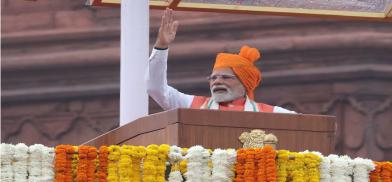Will Modi’s tax-reform promise work to unshackle Indian industry?
However, execution will determine whether Modi’s second GST gamble succeeds. Missteps could mean fiscal slippage, strained centre–state relations and political blowback in a crucial election cycle. What is being promoted as a festive bonanza risks being remembered as another midnight reform whose lofty promise faltered in practice.

From the ramparts of the Red Fort this Independence Day on August 15, Prime Minister Narendra Modi offered Indians a pledge of liberation — not from colonial rule, but from the labyrinthine tax system his government created eight years earlier.
In 2017, Modi convened a rare midnight session of parliament, consciously echoing Jawaharlal Nehru’s 1947 “tryst with destiny” speech, to inaugurate the Goods and Services Tax.
Billed as a “Good and Simple Tax,” it quickly devolved into a sprawling structure of five slabs, countless exemptions and frequent disputes.
A Diwali Gift for Indians?
Now, Modi is seeking redemption. By Diwali, he has promised to introduce “next generation” GST reforms, collapsing five slabs into two — 5 and 18 per cent — with a punitive 40 per cent for alcohol and tobacco.
The plan, packaged as a festive “Diwali gift,” is aimed squarely at households battered by inflation and small businesses weary of compliance.
Everyday essentials such as soap and cooking oil are to move to the lower bracket, while items like refrigerators and television sets would fall from 28 to 18 per cent, reducing costs for consumers and manufacturers alike.
Political and economic calculus
The reforms come as India confronts slowing demand and as state elections approach. Strategically, they anticipate tariff reductions under ongoing trade talks with the US, EU and UK.
With import duties set to fall, New Delhi hopes lower GST rates will help Indian producers stay competitive against Southeast Asian peers, where VAT rates are far lower.
The government is betting on a familiar formula: that lower rates will stimulate demand, broaden the base and eventually raise revenue.
The expiry of the GST compensation cess, which had cushioned states against revenue losses, has created just enough fiscal space to attempt the gamble.
Fiscal and administrative risks
The short-term revenue impact could be significant. State governments, already bracing for the loss of compensation transfers in December, risk budgetary strain on health and education spending.
Analysts warn of resistance within the GST Council, where states may be reluctant to subsidise what they see as New Delhi’s politically timed reform.
The administrative burden is equally daunting. Some 1,500 goods and services will require reclassification. Companies will need to update billing systems, retrain staff and reprogramme software — costs that weigh heavily on smaller firms.
Structural weaknesses also remain unaddressed. Petroleum products continue to sit outside GST, undermining the claim of a unified indirect tax.
Leakages persist in real estate and the informal sector. Analysts feel without strict enforcement of anti-profiteering rules, businesses could simply pocket savings rather than pass them on to consumers.
Market distortions and sentiment
Announcing deep rate cuts two months in advance has already distorted the market.
Distributors are holding back purchases in anticipation of October’s rollout, and consumer goods groups warn of inventory pile-ups.
International precedents such as Malaysia’s GST experiment, suggest that managing consumer expectations and ensuring enforcement will be critical.
If cheaper rates do not translate swiftly into lower retail prices, the political dividend could evaporate.
For businesses, the short-term disruption may overshadow the promise of longer-term gains.
High-stakes reform
Few question the need for simplification. Since 2017, the GST’s multiple rates and exemptions have fuelled litigation and distorted supply chains. Streamlining slabs could restore credibility to India’s flagship tax reform.
However, execution will determine whether Modi’s second GST gamble succeeds. Missteps could mean fiscal slippage, strained centre–state relations and political blowback in a crucial election cycle. What is being promoted as a festive bonanza risks being remembered as another midnight reform whose lofty promise faltered in practice.
(The author is a senior journalist and strategic analyst who specialises in the political economy. Views expressed are personal)









Post a Comment